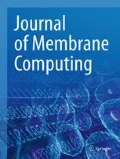Abstract
Reaction systems, introduced by Ehrenfeucht and Rozenberg, are a theoretical model of computation based on the two main features of biochemical reactions: facilitation and inhibition, which are captured by the individual reactions of the system. All reactions, acting together, determine the global behavior or the result function, res, of the system. In this paper, we study decomposing of a given result function to find a functionally equivalent set of reactions. We propose several approaches, based on identifying reaction systems with Boolean functions, Boolean formulas, and logic circuits. We show how to minimize the number of reactions and their resources for each single output individually, as a group, and when only a subset of the states are considered. These approaches work both when the reactions of the given res function are known and not known. We characterize the minimal number of reactions through the minimal number of logical terms of the Boolean formula representation of the reaction system. Finally, we make applications recommendations for our findings.




Similar content being viewed by others
Notes
Logic Friday 1.1.4, (c) Steve Rickman.
Although the cells of the Karnaugh map themselves are ordered according to a Gray code, it is still a surprise to see the code clearly spelled out in the diagram.
References
Azimi, S., Gratie, C., Ivanov, S., Manzoni, L., Petre, I., & Porreca, A. E. (2016). Complexity of model checking for reaction systems. Theoretical Computer Science, 623, 103–113. https://doi.org/10.1016/j.tcs.2015.11.040.
Barbuti, R., Gori, R., Levi, F., & Milazzo, P. (2016). Investigating dynamic causalities in reaction systems. Theoretical Computer Science, 623, 114–145. https://doi.org/10.1016/j.tcs.2015.11.041.
Brayton, R. K., Hachtel, G. D., McMullen, C. T., & Sangiovanni-Vincentelli, A. L. (1984). Logic minimization algorithms for VLSI synthesis. Amsterdam: Kluwer Academic Publishers.
Brijder, R., Ehrenfeucht, A., Main, M., & Rozenberg, G. (2011). A tour of reaction systems. International Journal of Foundations of Computer Science, 22, 1499–1517. https://doi.org/10.1142/S0129054111008842.
Corolli, L., Maja, C., Marini, F., Besozzi, D., & Mauri, G. (2012). An excursion in reaction systems: From computer science to biology. Theoretical Computer Science, 454, 95–108. https://doi.org/10.1016/j.tcs.2012.04.003.
Ehrenfeucht, A., & Rozenberg, G. (2007). Reaction systems. Fundamenta Informaticae, 75, 263–280.
Ehrenfeucht, A., Kleijn, J., Koutny, M., & Rozenberg, G. (2017). Evolving reaction systems. Theoretical Computer Science, 682, 79–99. https://doi.org/10.1016/j.tcs.2016.12.031.
Ehrenfeucht, A., Kleijn, J., Koutny, M., & Rozenberg, G. (2012). Minimal reaction systems. In: C. Priami, I. Petre, E. de Vink (eds) Transactions on Computational Systems Biology XIV. Lecture Notes in Computer Science, 7625, 102–122 https://doi.org/10.1007/978-3-642-35524-0_5
Genova, D., Hoogeboom, H. J., & Jonoska, N. (2017). A graph isomorphism condition and equivalence of reaction systems. Theoretical Computer Science, 701, 109–119. https://doi.org/10.1016/j.tcs.2017.05.019.
Gurunath, B., & Biswas, N.N. (1989) An algorithm for multiple output minimization. IEEE Trans. on CAD of Integrated Circuits and Systems 8, 1007–1013. https://doi.org/10.1109/43.35553
Karnaugh, M. (1953). The map method for synthesis of combinational logic circuits. Transactions of the American Institute of Electrical Engineers, Part I: Communication and Electronics, 72, 593–599. https://doi.org/10.1109/TCE.1953.6371932.
Kleijn, J., Koutny, M., & Mikulski, Ł. (2020). Reaction systems and enabling equivalence. Fundamenta Informaticae, 171, 261–277. https://doi.org/10.3233/FI-2020-1882.
McCluskey, E. J, Jr. (1956). Minimization of Boolean functions. Bell System Technical Journal, 35, 1417–1444. https://doi.org/10.1002/j.1538-7305.1956.tb03835.
Meyer, A.R., & Stockmeyer, L.J. (1972). The equivalence problem for regular expressions with squaring requires exponential space. Proceedings of the 13th IEEE Symposium on Switching and Automata Theory, 125–129. https://doi.org/10.1109/SWAT.1972.29
Rudell, R.L., & Sangiovanni-Vincentelli, A.L. (1987). Multiple-valued minimization for PLA optimization. IEEE Trans. on CAD of Integrated Circuits and Systems 6, 727–750. https://doi.org/10.1109/TCAD.1987.1270318
Rudell, R., Sangiovanni-Vincentelli, A. (2003). Exact minimization of multiple-valued functions for PLA optimization. In: Kuehlmann A. (eds) The Best of ICCAD. Springer, Boston, MA. https://doi.org/10.1007/978-1-4615-0292-0_16
Salomaa, A. (2013). Minimal and almost minimal reaction systems. Natural Computing, 12, 369–376. https://doi.org/10.1007/s11047-013-9372-y.
Salomaa, A. (2012). On state sequences defined by reaction systems. Kozen Festschrift, Lecture Notes in Computer Science 7230, 271–282. https://doi.org/10.1007/978-3-642-29485-3_17.
Umans, C. (2001). The minimum equivalent DNF problem and shortest implicants. Journal of Computer and System Sciences, 63, 597–611. https://doi.org/10.1006/jcss.2001.1775.
Acknowledgements
This research was initiated at and facilitated by the 2nd International Workshop in Reaction Systems and 1st School in Reaction Systems held on June 3, 2019, organized by Nicolaus Copernicus University, Toruń, Poland. DG and HJH acknowledge travel support from InterAPS (International Academic Partnerships in Sciences with Nicolaus Copernicus University) and from the University of North Florida, USA. The authors thank Matthew Thomas for useful comments on a previous version of this paper. The authors are also very grateful for the thoughtful suggestions from three anonymous referees, which have improved the presentation of this paper.
Author information
Authors and Affiliations
Corresponding author
Ethics declarations
Conflicts of interest
On behalf of all authors, the corresponding author states that there is no conflict of interest.
Additional information
Publisher's Note
Springer Nature remains neutral with regard to jurisdictional claims in published maps and institutional affiliations.
Rights and permissions
About this article
Cite this article
Genova, D., Hoogeboom, H.J. & Prodanoff, Z. Extracting reaction systems from function behavior. J Membr Comput 2, 194–206 (2020). https://doi.org/10.1007/s41965-020-00045-z
Received:
Accepted:
Published:
Issue Date:
DOI: https://doi.org/10.1007/s41965-020-00045-z




